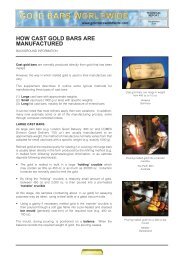Indian Gold Book:Indian Gold Book - Gold Bars Worldwide
Indian Gold Book:Indian Gold Book - Gold Bars Worldwide
Indian Gold Book:Indian Gold Book - Gold Bars Worldwide
Create successful ePaper yourself
Turn your PDF publications into a flip-book with our unique Google optimized e-Paper software.
GOLD SUPPLY AND DEMAND<br />
Coins and TT bars<br />
Anecdotal evidence suggests that more than 50% of annual coin fabrication is converted into jewellery over time.<br />
It also suggests (at this time) that most TT bars bought for personal hoarding would enter the jewellery market (i.e. sold<br />
for cash), or would be converted into jewellery, over time.<br />
Many coin and TT bar purchases appear to act as deferred purchases of gold jewellery.<br />
Consolidated gross supply<br />
When recycling is taken fully into account, gross annual supply is broadly estimated at 1,053 tonnes in 2001.<br />
Gross supply 2001 2000<br />
New gold 681 680<br />
Recycled gold 372 347<br />
Total 1,053 1,027<br />
Source: See appendix “Indicative gross fabrication and demand”.<br />
To repeat, an estimate of the amount of gold recycled can only be indicative. The important point is that the amount is<br />
substantial, and sensitive to movements in the gold price.<br />
NET DEMAND<br />
In a gold market that comprises hundreds of thousands of family retailers and fabricators, the breakdown of<br />
demand is obliged to rely on an interpretation of anecdotal evidence. There are no firm statistics.<br />
In this section, net gold jewellery demand (i.e. excludes fabrication from recycled gold) and net bar hoarding are combined<br />
for 3 reasons. Both have an investment dimension. Hoarded bars tend to enter the jewellery market over time. Among<br />
analysts there is also not yet a broad consensus about the split. This report does suggest a tentative split, based on<br />
available anecdotal evidence. Its net bar hoarding estimate is low.<br />
1990 – 1997 (8 years)<br />
Net demand for gold in all categories rose rapidly over the period from 178 tonnes in 1990 to 645 tonnes in 1997.<br />
Industrial fabrication increased from less than 2 tonnes to an indicative 18 tonnes, due mainly to an increase in the use of<br />
gold for Zari crafts.<br />
Coin fabrication grew from zero, as fabrication was banned under the <strong>Gold</strong> (Control) Act, to an indicative 19 tonnes.<br />
Net jewellery fabrication & bar hoarding increased from 176 tonnes to 609 tonnes. The reason for its rapid growth was the<br />
outcome of several factors:<br />
• Restrictions on gold ownership during the <strong>Gold</strong> (Control) Act had generated pent-up demand.<br />
• Jewellery became more accessible when the number of retailers increased from 16,000 to more than 200,000.<br />
• <strong>Gold</strong> could be officially imported by NRI’s.<br />
• Population increased by 14%.<br />
• Rural, and especially urban, wealth increased. Industrial production grew by 52%. Agricultural output was high in 1992<br />
- 94 and again in 1996. GDP grew by 37% in real terms.<br />
• Rupee gold price rose slowly and steadily each year, as it had done for decades, until 1996.<br />
• In 1997, when the annual average price fell for the first time in decades (by 12%), gold was viewed as inexpensive in a<br />
booming economy.<br />
1998 – 2001 (4 years)<br />
Net demand in total was largely static over this period, ranging between 650 - 690 tonnes.<br />
Industrial fabrication increased from 18 to an indicative 43 tonnes, due mainly to an increase in demand for gold plating<br />
purposes.<br />
Coin fabrication grew from 23 to an indicative 35 tonnes, influenced by increased corporate demand for coins as gifts and<br />
promotional prizes, and an increase in personal purchases.<br />
Net jewellery fabrication & bar hoarding appears to have declined. In 2001 (603 tonnes) it appears to have been 7% less<br />
than in 1998 (650 tonnes).<br />
Why was net demand largely static when there were so many positive factors such as the following?<br />
• Population grew by 6%.<br />
• GDP increased by 26%.<br />
• <strong>Gold</strong> was less expensive - the price, static in nominal terms, fell in real terms.<br />
168<br />
AN INTRODUCTION TO THE INDIAN GOLD MARKET

















